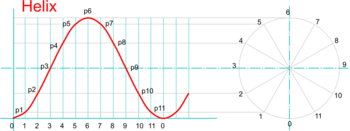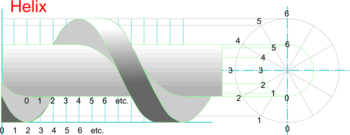Helix: Difference between revisions
From DT Online
(Changed Images) |
(Added Template) |
||
| Line 1: | Line 1: | ||
__TOC__ | |||
=====Description===== | |||
A [https://en.wikipedia.org/wiki/Helix '''Helix'''] is the '''[[Loci|locus of a point]]''' travelling with '''[[Types of Motion|constant linear velocity]]''', axially along the outside of a cylinder as the cylinder rotates with '''[[Types of Motion|constant angular velocity]]'''. The axial distance travelled by the point for each revolution of the cylinder is known as the '''''pitch'''''. | A [https://en.wikipedia.org/wiki/Helix '''Helix'''] is the '''[[Loci|locus of a point]]''' travelling with '''[[Types of Motion|constant linear velocity]]''', axially along the outside of a cylinder as the cylinder rotates with '''[[Types of Motion|constant angular velocity]]'''. The axial distance travelled by the point for each revolution of the cylinder is known as the '''''pitch'''''. | ||
| Line 7: | Line 12: | ||
The elevation of this locus is a '''[[Types of Motion|Sine Curve]]''', which is also the curve used on a '''[[Displacement Diagram]]''' to generate '''[[Types of Motion|Simple Harmonic Motion]]''' to a '''[[Radial Cam|Cam Follower]]'''. | The elevation of this locus is a '''[[Types of Motion|Sine Curve]]''', which is also the curve used on a '''[[Displacement Diagram]]''' to generate '''[[Types of Motion|Simple Harmonic Motion]]''' to a '''[[Radial Cam|Cam Follower]]'''. | ||
=====Construction===== | |||
{| cellpadding="5" | {| cellpadding="5" | ||
| Line 36: | Line 43: | ||
---- | ---- | ||
{{Drawing Instruments Buyers Guide}} | |||
[[Category:Secondary]] | [[Category:Secondary]] | ||
[[Category:Geometry]] | [[Category:Geometry]] | ||
Revision as of 19:04, 2 June 2016
Description
A Helix is the locus of a point travelling with constant linear velocity, axially along the outside of a cylinder as the cylinder rotates with constant angular velocity. The axial distance travelled by the point for each revolution of the cylinder is known as the pitch.
A helix is the curve used to produce a screw and is common in screwthreads and coil springs.
The elevation of this locus is a Sine Curve, which is also the curve used on a Displacement Diagram to generate Simple Harmonic Motion to a Cam Follower.
Construction
| Drawing a Helix |
|
|
| Drawing Helical Screws and Springs |
|
Note: To draw an actual thread or spring its cross-section must be drawn at the starting point 0 and this used to determine the inner (or ‘core’) diameter, the pitch, and the number of helixes required.











